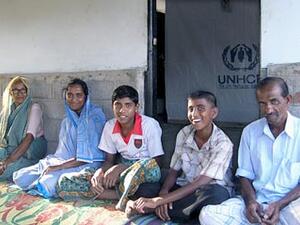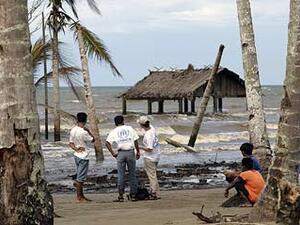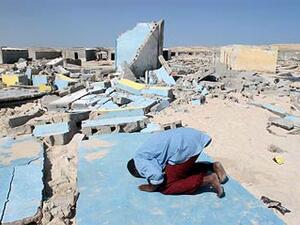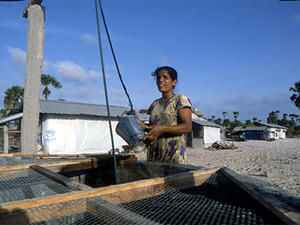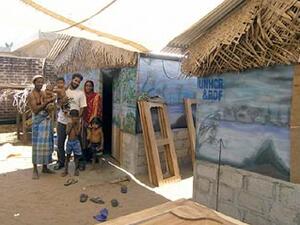UNHCR outlines post-tsunami role in Sri Lanka
UNHCR outlines post-tsunami role in Sri Lanka

Delivering tents to Kalutara in southern Sri Lanka. The airlift of 2,000 tents from Jordan to Colombo was sponsored by the Saudi Red Crescent Society.
GENEVA, Feb 4 (UNHCR) - The UN refugee agency has outlined its role in post-tsunami Sri Lanka amid continuing efforts to distribute non-food relief items to the displaced and to finalise a transitional shelter strategy in the devastated coastal areas.
Returning to Geneva from a three-week mission to tsunami-hit countries in Asia, UNHCR's Asia Pacific bureau director, Janet Lim, said on Friday, "In the north and east of Sri Lanka, we'll continue to help people displaced by the conflict and the tsunami, to make sure both groups receive equitable assistance."
She added, "In the south, where the government has a functioning structure in place, we will continue to help with emergency relief in the short term. We have also offered our expertise on issues like shelter, land and documentation."
UNHCR recently set up new offices in Matara in the south and Ampara in the east to facilitate relief efforts after the tsunami. These were in addition to seven existing offices in the north and east, where the refugee agency has, since 1987, been helping people displaced by the conflict between the government and the Liberation Tigers of Tamil Eelam (LTTE).
Prior to the December 26 tsunami, UNHCR had registered some 390,000 conflict-displaced people in Sri Lanka. Government figures in January put the tsunami-displaced at 441,000.
"A systematic collection of information is critical now. Without proper registration, we cannot get a comprehensive picture of who is where and what their needs are," said Lim, adding that UNHCR has offered technical advice on registering displaced people in the wake of the tsunami.
Meanwhile, the refugee agency continues to distribute shelter and non-food relief items to the displaced. More than 160,000 people have received supplies like plastic sheeting, mosquito nets, kitchen sets and clothing.
Responding to the authorities' requests, UNHCR is also distributing 2,000 tents throughout the country. Of these, 500 have been handed over to the Government Agent in Kalutara, 500 to UNHCR's office in Ampara and 200 to UNHCR in Matara. Another 1,000 have been sent to Vavuniya and Kilinochchi in the north, where they are awaiting clearance for distribution. Altogether, these tents can house up to 10,000 displaced people.
The 2,000 tents had been flown to Colombo from UNHCR's regional warehouse in Jordan through four airlifts sponsored by the Saudi Red Crescent Society with a contribution of $305,000. This was in addition to the $500,000 earlier pledged by Saudi Arabia's King Fahad to UNHCR's tsunami relief efforts in Indonesia and Sri Lanka.
Another 8,000 tents will arrive in Colombo shortly, including 5,500 by sea from Jordan, sponsored by Kuwaiti non-governmental organisation International Islamic Charitable Organization (costing $42,000), and 2,500 from Pakistan, donated by American NGO AmeriCares.
The Sri Lankan authorities had asked for tents to house tsunami-displaced people living in public buildings like schools and for vulnerable families who cannot return to their devastated homes in the near future.
UNHCR has stressed repeatedly that relocation must be voluntary and that the displaced people must be consulted before any move.
"We've started a survey to find out more about their needs, preferences and access to information on relocation," said UNHCR's Public Information Officer in Colombo, Lyndon Jeffels. "This information will enable the international community to support the government's decision-making on relocating or resettling displaced persons in accordance with the UN Guiding Principles on Internal Displacement."
The assessment, expected to last 10 days, covers some 300 households in the east (Ampara), south (Galle) and north (Jaffna).
"Many of the displaced people are living with friends or relatives," noted Jeffels. "We hope the survey will also shed light on the experiences and needs of these host families."
Given the scale of physical destruction in Sri Lanka, UNHCR recognises that many people will not be able to return home any time soon. As such, the agency is finalising a strategy for transitional shelter for the next six months, pending the rehabilitation or construction of more permanent homes.
The government has agreed on the strategy devised by UNHCR and its partners, which proposed two models of transitional shelter - a small moveable building, or shelter materials to repair partially damaged homes. The actual housing design will vary according to the refugee agency's implementing partners and local conditions.
UNHCR is currently collating feedback from its shelter partners in the field, and expects to put the strategy into action this month.


